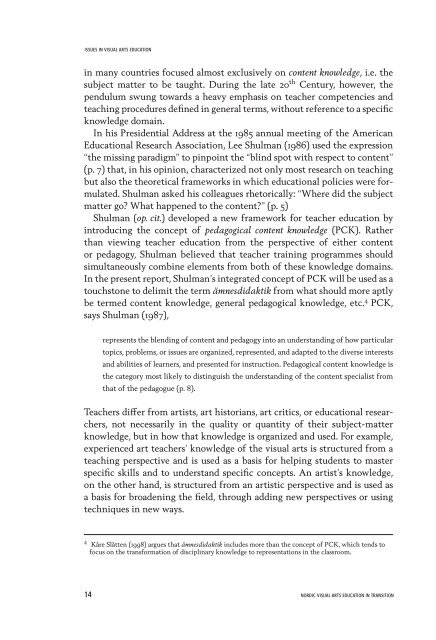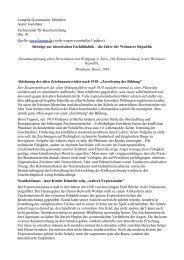Research in Visual Arts Education - The National Society for ...
Research in Visual Arts Education - The National Society for ...
Research in Visual Arts Education - The National Society for ...
You also want an ePaper? Increase the reach of your titles
YUMPU automatically turns print PDFs into web optimized ePapers that Google loves.
ISSUES IN VISUAL ARTS EDUCATION<br />
<strong>in</strong> many countries focused almost exclusively on content knowledge, i.e. the<br />
subject matter to be taught. Dur<strong>in</strong>g the late 20 th Century, however, the<br />
pendulum swung towards a heavy emphasis on teacher competencies and<br />
teach<strong>in</strong>g procedures def<strong>in</strong>ed <strong>in</strong> general terms, without reference to a specific<br />
knowledge doma<strong>in</strong>.<br />
In his Presidential Address at the 1985 annual meet<strong>in</strong>g of the American<br />
<strong>Education</strong>al <strong>Research</strong> Association, Lee Shulman (1986) used the expression<br />
“the miss<strong>in</strong>g paradigm” to p<strong>in</strong>po<strong>in</strong>t the “bl<strong>in</strong>d spot with respect to content”<br />
(p. 7) that, <strong>in</strong> his op<strong>in</strong>ion, characterized not only most research on teach<strong>in</strong>g<br />
but also the theoretical frameworks <strong>in</strong> which educational policies were <strong>for</strong>mulated.<br />
Shulman asked his colleagues rhetorically: “Where did the subject<br />
matter go What happened to the content” (p. 5)<br />
Shulman (op. cit.) developed a new framework <strong>for</strong> teacher education by<br />
<strong>in</strong>troduc<strong>in</strong>g the concept of pedagogical content knowledge (PCK). Rather<br />
than view<strong>in</strong>g teacher education from the perspective of either content<br />
or pedagogy, Shulman believed that teacher tra<strong>in</strong><strong>in</strong>g programmes should<br />
simultaneously comb<strong>in</strong>e elements from both of these knowledge doma<strong>in</strong>s.<br />
In the present report, Shulman’s <strong>in</strong>tegrated concept of PCK will be used as a<br />
touchstone to delimit the term ämnesdidaktik from what should more aptly<br />
be termed content knowledge, general pedagogical knowledge, etc. 4 PCK,<br />
says Shulman (1987),<br />
represents the blend<strong>in</strong>g of content and pedagogy <strong>in</strong>to an understand<strong>in</strong>g of how particular<br />
topics, problems, or issues are organized, represented, and adapted to the diverse <strong>in</strong>terests<br />
and abilities of learners, and presented <strong>for</strong> <strong>in</strong>struction. Pedagogical content knowledge is<br />
the category most likely to dist<strong>in</strong>guish the understand<strong>in</strong>g of the content specialist from<br />
that of the pedagogue (p. 8).<br />
Teachers differ from artists, art historians, art critics, or educational researchers,<br />
not necessarily <strong>in</strong> the quality or quantity of their subject-matter<br />
knowledge, but <strong>in</strong> how that knowledge is organized and used. For example,<br />
experienced art teachers’ knowledge of the visual arts is structured from a<br />
teach<strong>in</strong>g perspective and is used as a basis <strong>for</strong> help<strong>in</strong>g students to master<br />
specific skills and to understand specific concepts. An artist’s knowledge,<br />
on the other hand, is structured from an artistic perspective and is used as<br />
a basis <strong>for</strong> broaden<strong>in</strong>g the field, through add<strong>in</strong>g new perspectives or us<strong>in</strong>g<br />
techniques <strong>in</strong> new ways.<br />
4 Kåre Slåtten (1998) argues that ämnesdidaktik <strong>in</strong>cludes more than the concept of PCK, which tends to<br />
focus on the trans<strong>for</strong>mation of discipl<strong>in</strong>ary knowledge to representations <strong>in</strong> the classroom.<br />
14 NORDIC VISUAL ARTS EDUCATION IN TRANSITION



